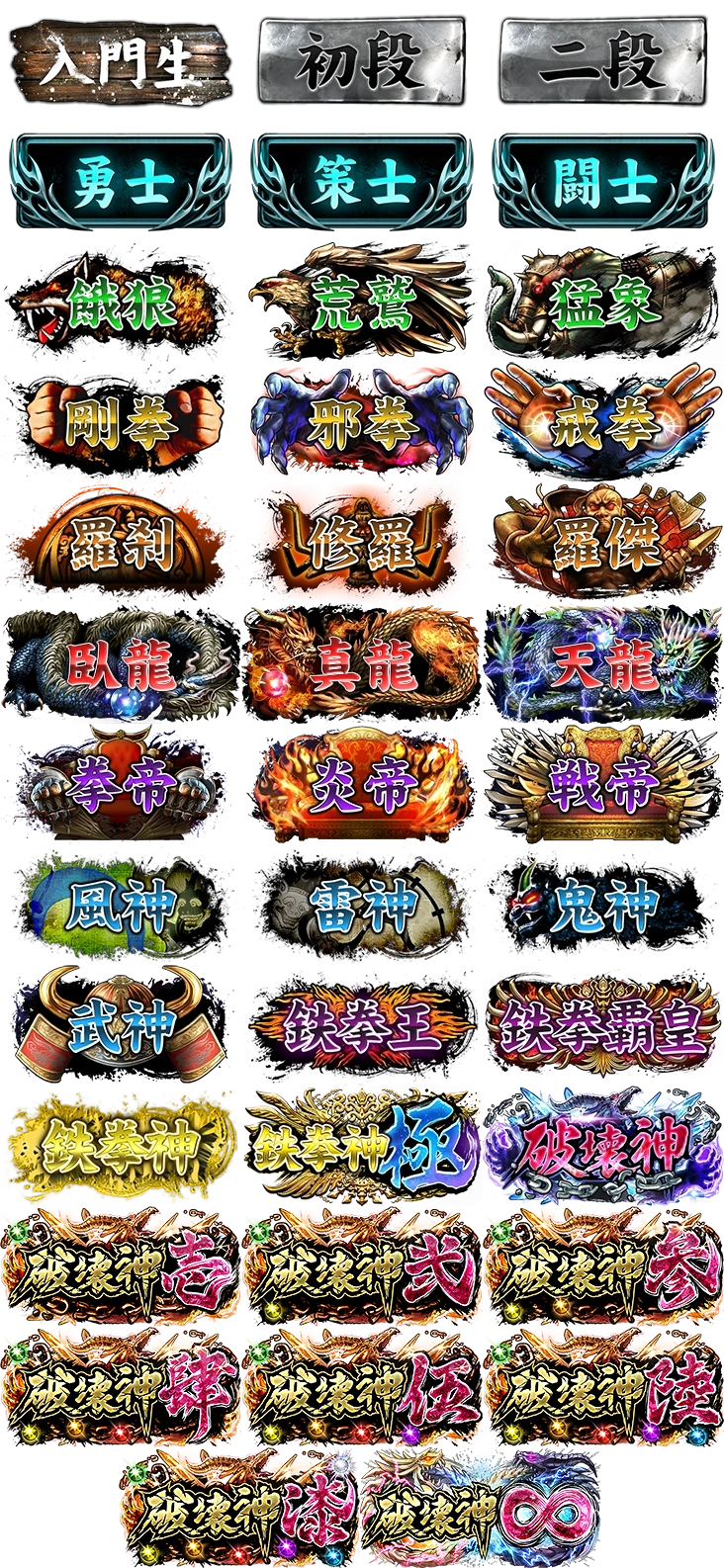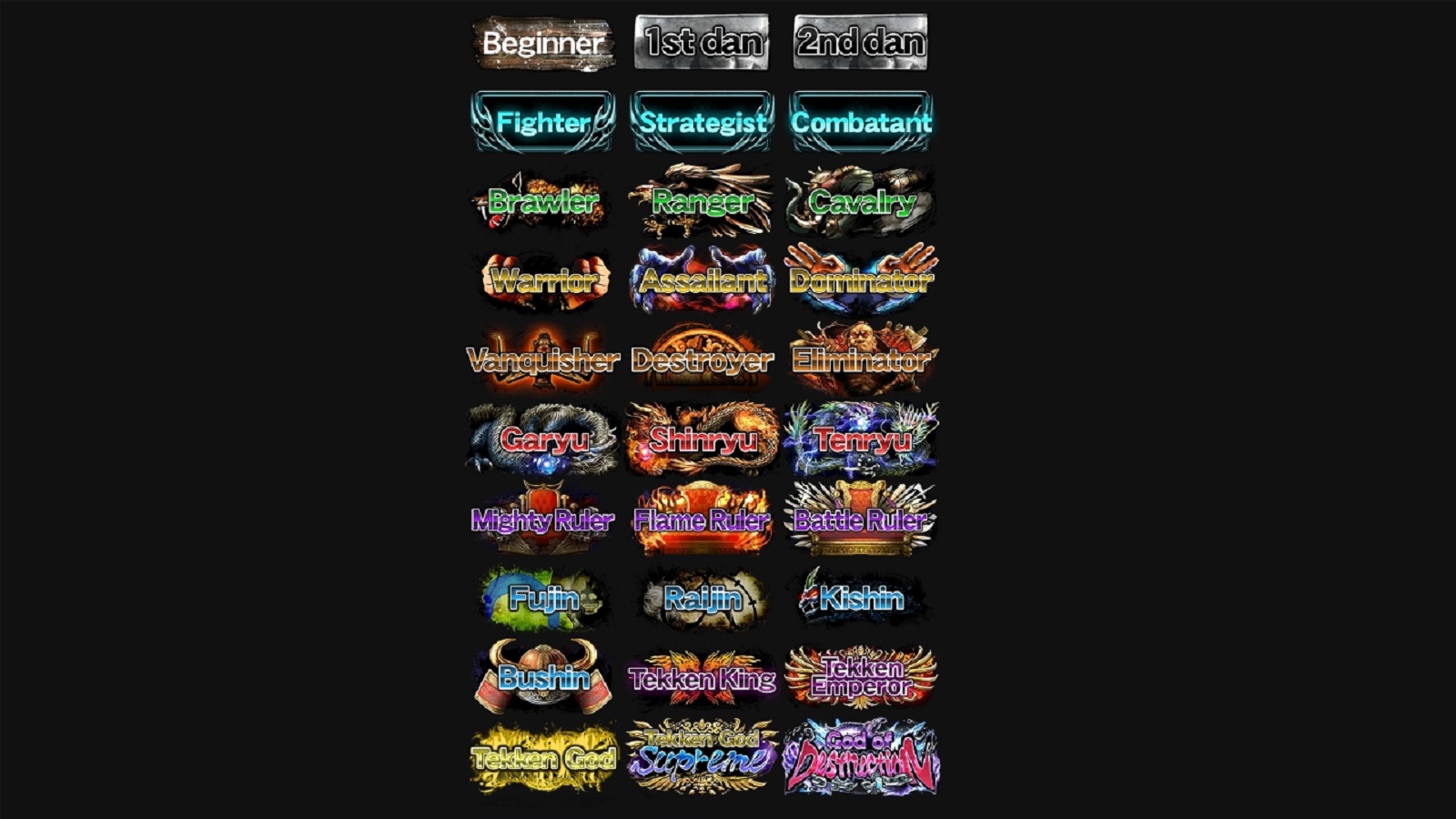Ever wondered what separates a Tekken novice from a Tekken God? It's all about the ranks, baby! From the humble beginnings of a Beginner to the almost mythical status of Tekken God Omega, the ranking system in Tekken 8 is the very lifeblood of the competitive scene. It’s the yardstick by which we measure our skill, our dedication, and our ability to unleash devastating combos on unsuspecting opponents.
Tekken, the legendary 3D fighting game that first graced our arcades and consoles in 1994, continues to evolve with its latest installment, Tekken 8. This newest entry, launched on January 26, 2024, for PlayStation 5, Windows, and Xbox Series X/S, isn't just a visual upgrade; it's a complete overhaul of the fighting experience, especially when it comes to how players are assessed and ranked. The online forum R/tekken is your virtual dojo, teeming with discussions about everything from frame data and character matchups to the electrifying Tekken esports scene. But at the core of these discussions is always the burning question: "What's your rank?"
| Category | Information |
|---|---|
| Game Title | Tekken 8 |
| Release Date | January 26, 2024 |
| Developer | Bandai Namco Studios & Arika |
| Genre | 3D Fighting Game |
| Platforms | PlayStation 5, Windows, Xbox Series X/S |
| Ranking System Origin | Tekken 5 |
| Number of Ranks (Season 1) | 30 |
| Number of Ranks | 37 |
| Color Groups/Belts | 10 |
| Highest Achievable Rank | Tekken God Omega |
| Community Hub | R/tekken on Reddit |
| Key Resource Site | TekkenDocs |
The essence of the Tekken experience lies in the competitive climb. The "Tekken 8 ranks" are more than just badges; they're a representation of your journey, a testament to your dedication, and a beacon to other players signaling your level of prowess. In Tekken 8, the ranking system has been carefully crafted to provide a fair and engaging experience, pushing players to constantly improve and adapt. Gone are the days of simple win-loss ratios dictating your place. Tekken 8 incorporates a more nuanced approach, considering various factors to accurately reflect a player's skill.
As previously mentioned, Season 1 of Tekken 8 featured a total of 30 ranks, from the tentative steps of a "Beginner" to the godlike aura of "Tekken God of Destruction." However, with the advent of Season 2, the landscape has shifted. The developers have acknowledged the ever-growing skill ceiling and introduced new tiers at the very top, extending the ladder for those vying for ultimate supremacy. The goal is to ensure that even the most seasoned veterans have something to strive for, a new mountain to climb, and a reason to hone their skills even further.
The journey begins with those initial brown ranks: Beginner, 1st Dan, and 2nd Dan. To escape the "Beginner" designation, a player must accumulate 400 points to progress to 1st Dan. These early ranks are designed to ease new players into the game, teaching them the fundamentals of movement, attack, and defense. It's a trial by fire, where basic strategies are tested and refined. These initial steps are crucial for building a solid foundation upon which more advanced techniques can be built.
One of the best resources for understanding the intricacies of the ranking system is Phidx's video analysis. Phidx delves into the mechanics of each rank, meticulously explaining the points gained and lost for victories and defeats. He also highlights the "promotion buffers," those crucial safety nets that protect you from immediate demotion after reaching a new rank. These buffers provide a cushion, allowing players to adapt to the new level of competition without the constant fear of falling back down.
The Tekken 8 ranking list is far from static. It's a dynamic ecosystem where players are constantly moving up and down the ladder, driven by their wins, their losses, and their relentless pursuit of improvement. Understanding the distribution of players across these ranks provides valuable insights into the game's overall meta. It reveals the skill levels of the average player, the challenges faced at each tier, and the dedication required to reach the upper echelons. This information is invaluable for setting realistic goals and charting a course for improvement.
Independent websites like TekkenDocs serve as invaluable repositories of knowledge, offering detailed frame data, character guides, and advanced techniques. These resources are essential for players who are serious about climbing the ranks, providing the tools and information necessary to master their chosen characters and strategies. Frame data, in particular, is a crucial element for high-level play, allowing players to understand the precise timings of moves and create optimized combos.
While the core gameplay of Tekken 8 remains true to its roots, the ranking system has undergone significant refinements compared to Tekken 7. One notable change is the reduction in the number of ranks within certain divisions, moving from four to three. This streamlining aims to create a more concise and less fragmented progression system. Additionally, the "floor" for ranks, which protects against demotion, has been raised. This change is intended to prevent players from yo-yoing between ranks, but it also has the potential to contribute to rank inflation over time.
DashFight, another resource for competitive fighting game enthusiasts, has also weighed in on the Tekken 8 ranking system. Initially, DashFight aggregated world rankings from other platforms. However, this approach faced criticism due to inconsistencies and perceived inaccuracies. Responding to community feedback, DashFight developed its own unique ranking system, designed to provide a more accurate and reliable assessment of player skill.
The official patch notes for Tekken 8 Season 2 explicitly acknowledge the increasing difficulty of ranking up as players approach the highest tiers, particularly the "God of Destruction" rank. To address this challenge and provide additional motivation for top-tier players, the developers introduced eight sub-tiers within the "God of Destruction" rank. This expansion allows for greater granularity in skill assessment and provides a more meaningful progression path for the elite players.
The Tekken 8 ranking system is, in essence, a proving ground. It's where players test their mettle against others, refine their strategies, and ultimately, determine their place in the Tekken hierarchy. The journey from Beginner to Tekken God Omega is a long and arduous one, filled with challenges, setbacks, and moments of triumph. But for those who persevere, the rewards are well worth the effort. The sense of accomplishment that comes from reaching a new rank, the respect earned from fellow players, and the thrill of competition – these are the things that make the Tekken 8 ranking system so compelling.
But how does the game determine your rank? What factors come into play when awarding you those coveted ranking points? The system, while not as complex as an ELO-based system, is certainly more intricate than simply counting wins and losses. It considers a variety of factors, including the rank of your opponent, the outcome of the match, and even your overall performance. The more you win against higher-ranked opponents, the faster you'll climb the ladder.
Your Tekken 8 journey, regardless of your current rank, is a testament to your dedication and passion for the game. So, embrace the challenge, learn from your mistakes, and keep striving to improve. The ranks are there for the taking. It’s important to remember that the ranking system is not a perfect measure of skill. There will be times when you feel like you're stuck in a rut, or when you encounter opponents who seem to be far above or below your skill level. But don't let these challenges discourage you. Instead, view them as opportunities to learn and grow.
The ranking structure consists of distinct tiers. The first three ranks in Tekken 8 are Beginner, 1st Dan, and 2nd Dan, representing the initial stages of a player's journey. These ranks are designed to ease new players into the game, providing a gentler introduction to the core mechanics and strategies. Beginner is the only rank in the brown division, and players need 400 points to advance to 1st Dan, which is in a higher division. From there, the ranks progressively increase in difficulty, requiring more skill and strategic thinking to climb.
For those looking to optimize their climb, understanding the specifics of point gain and loss is crucial. Phidx’s video analysis sheds light on this intricate system, breaking down how many points are awarded for victories and deducted for defeats at each rank. He also explains the function of promotion buffers, which offer a degree of protection against immediate demotion after reaching a new rank. These buffers allow players to adjust to the higher level of competition without the constant fear of falling back down.
The opponent selection process in ranked matches ensures fair play and competitive growth by matching players with opponents of similar skill levels. This approach aims to provide challenging but winnable matches, fostering an environment where players can constantly improve. While occasional mismatches may occur, the system generally strives to create balanced encounters that test a player's abilities.
Tekken 8 boasts a wide range of ranks, designed to accommodate players of all skill levels. The specific number of ranks may vary slightly between seasons, but the overall structure remains consistent. Each rank signifies a player's skill level, starting from Beginner and progressing through multiple tiers. This progression system provides a tangible measure of a player's progress and serves as motivation to continue improving.
Understanding how ranks work in Tekken 8 involves recognizing the factors that influence rank progression. The game takes into account various elements, including the player's win-loss ratio, the ranks of their opponents, and their overall performance in matches. By considering these factors, the ranking system aims to provide a more accurate and nuanced assessment of a player's skill.
The ranked system in Tekken 8 distinguishes itself from other fighting games by taking a unique approach to skill assessment. Rather than relying solely on win-loss ratios, the system incorporates a variety of factors to provide a more comprehensive evaluation of a player's abilities. This approach encourages players to focus on improving their overall gameplay, rather than simply grinding out wins.
Ranking in Tekken 8 is a skill-based system that has been a staple of the series since its introduction in Tekken 5. This system rewards players for their progress and provides a clear indication of their skill level. Ranks are obtained by winning a certain number of matches and then succeeding in a promotion match, which tests the player's ability to perform under pressure.
Players can earn promotions by playing offline matches in Treasure Battle or Arcade Mode, where they can battle computer opponents and earn ranking points. However, the primary method of ranking up is through online matches, where players compete against others of similar skill levels. The rewards for ranking up in Tekken 8 include cosmetic items, character customization options, and the satisfaction of knowing that you've improved your skills.
The ranks list in Tekken 8 is designed to signify a player’s skill level, starting from beginner and advancing through multiple tiers. As players progress through the ranks, they face increasingly challenging opponents and must refine their strategies to continue climbing. This constant need for improvement is what makes the Tekken 8 ranking system so engaging and rewarding.
In season 1, the most populated rank was fujin, rank 22 and the first blue belt. In season 2 the average rank is currently lower due to the reset. Tekken 8 is the latest installment in the fighting game franchise, offering players a deep and rewarding ranked experience. Whether you're a seasoned veteran or a newcomer to the series, the ranking system provides a clear path for improvement and a constant stream of challenges to overcome.
Tekken 8 ranks have become the heartbeat of the game, offering players a tangible measure of their skill, perseverance, and strategic prowess. From the novice fighters testing their mettle in the lower echelons to the seasoned masters vying for the coveted title of tekken god prime, each rank represents a unique challenge and an opportunity for. Tekken 8 has 37 ranks. They are divided into 10 color groups know as belts.
In conclusion, the Tekken 8 ranking system is a complex and dynamic ecosystem that drives the competitive spirit of the game. It's a journey of self-improvement, strategic refinement, and relentless pursuit of victory. So, step into the arena, embrace the challenge, and see how far you can climb. The ranks await.


